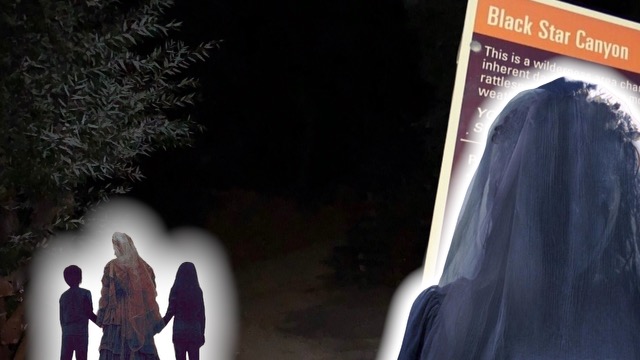[dropcap size=big]L[/dropcap]ocated a few minutes east of Orange near the unincorporated town of Silverado, Black Star Canyon’s 6.7-mile eponymous trail offers a breathtaking daytime adventure through Orange County’s Santa Ana Mountains as it weaves past lush greenery, dramatic open spaces, waterfalls, and Native American ruins. Unless you’re an outdoor enthusiast, none of these things matter.
Black Star Canyon chiefly exists as Orange County’s creepiest spot when the sun goes down for the rest of us. The name itself has the power to cajole slight chills, and not just because it sounds like a fitting title for a doom metal album. Its spate of eerie ghost stories, nocturnal rumors, and erstwhile folklore bestow it with a powerful, strange mythos, whether you believe in them or not.
Southern California residents that are familiar with Black Star Canyon’s spooky side likely know of its greatest hits: Ritualistic devil worship, KKK gatherings, shotgun-brandishing locals with Wild West-sounding nicknames like “Black Star Bill,” vengeful spirits of murdered Native Americans.
However, the canyon’s most intriguing story may come from one of its deeper album cuts: La Llorona, the infamous weeping woman, so deeply ingrained in Latin American folklore, allegedly roams Black Star Canyon, mournfully searching the adjacent Black Star Creek in vain for the children she supposedly drowned.
Orange County as La Llorona’s Origin Story
At first, La Llorona’s tragic tale may seem like a new addition to Black Star Canyon’s gallery of ghosts and ghouls, introduced by the growing multi-generational influx of Latinos in Orange County communities like Santa Ana and Anaheim. Yet while she’s not as well-publicized as some of the canyon’s other bits of folklore, she’s thought by some to be the canyon’s oldest ghost story. This may sound strange given Orange County’s contemporary post-WWII history, which screams white bread suburbia. It makes a whole lot more sense when one considers the region’s earliest, pre-California statehood days.
Present-day Orange County’s earliest non-indigenous settlers were Spanish explorers. They first set foot here in July of 1769 and started colonizing shortly after that. These original settlers likely brought stories of La Llorona with them from Baja, California. This would fit her legend’s theorized pre-Hispanic timeline.
The land became part of the new Spanish province of Alta California in 1804; six years later, the Spanish government issued a land concession to Jose Antonio Yorba, a corporal that helped Father Junipero Serra found Mission San Juan Capistrano in 1776. It was the first of many land concessions given to the Yorba family from Spain and post-independence Mexico. The acreage they owned stretched from Huntington Beach to Corona in Riverside County. One of these grants, Rancho Lomas de Santiago, encompassed Black Star Canyon.
While there’s no way to know for sure, it is not a stretch to imagine La Llorona’s folkloric account affixed to Black Star Canyon during the Yorba family’s land empire if only to hand down her troubled legacy to future generations. After all, the canyon’s Black Star Creek gave her the water feature she needs to exist properly; imagination and storytelling would have taken care of the rest. If the legend was also applied to other water-adjacent parts of the Yorbas’ land, it didn’t stick. That makes perfect sense if that’s the case—it’s tough to be creeped out by the Newport Back Bay.
La Llorona’s alleged Black Star Canyon manifestations keep with tradition. She appears in a white dress. The sounds she makes are loud, sorrowful sobs. While she may be the stuff of conjecture, the thought of potentially encountering her during a moonlight stroll—or a different specter that appears or sounds the same way—is plenty to fill the bones with nervous excitement.
Her story also drives home an important element to Black Star Canyon’s myriad tales of spooky lore. Whether they’re real or not, they provide thought-provoking connections to Orange County’s past in a way that can’t quite be duplicated elsewhere. It can be argued that rumors of the Canyon’s KKK assemblies continue to exist because of OC’s sordid past association with the group. Likewise, the notion of devil worshippers congregating in the canyon feels like remnants of the Satanic Panic in the ‘80s, which inadvertently points to Orange County’s status as a launching pad for evangelical megachurches. Those Native American ghost stories? Their roots trace to an 1831 Indian tribe massacre that people insist happened despite a complete lack of documented evidence around its supposed occurrence. All accounts of the incident happening stem from a winter-of-life confession from its ringleader, William Wolfskill, some 70 years after the fact. This makes the story shaky at best, but even if it was fabricated, it still has some semblance of historic merit—Wolfskill created the Valencia orange.
In the case of La Llorona, her haunting of Black Star Canyon compels us to shove past O.C.’s image of suburbia and ponder its Spanish colonial roots. That may not be as fun as getting the crap scared out of you by an errant, mysterious sound echoing through the canyon, but it’s definitely something that matters.
Check out our very own L.A. TACO paranormal investigation into Black Star Canyon's alleged history with La Llorona. This video was produced by East L.A.'s homegrown Paranormal Investigator, Victor Huesca, and was a collaboration with his DIY ghost-hunting show on Youtube, Barrier Beyond. Make sure to subscribe to both Barrier Beyond and L.A. TACO's Youtube accounts for more street-level journalism videos. To find out more about Victor Huesca, read our profile on him published last year.







